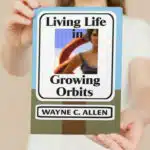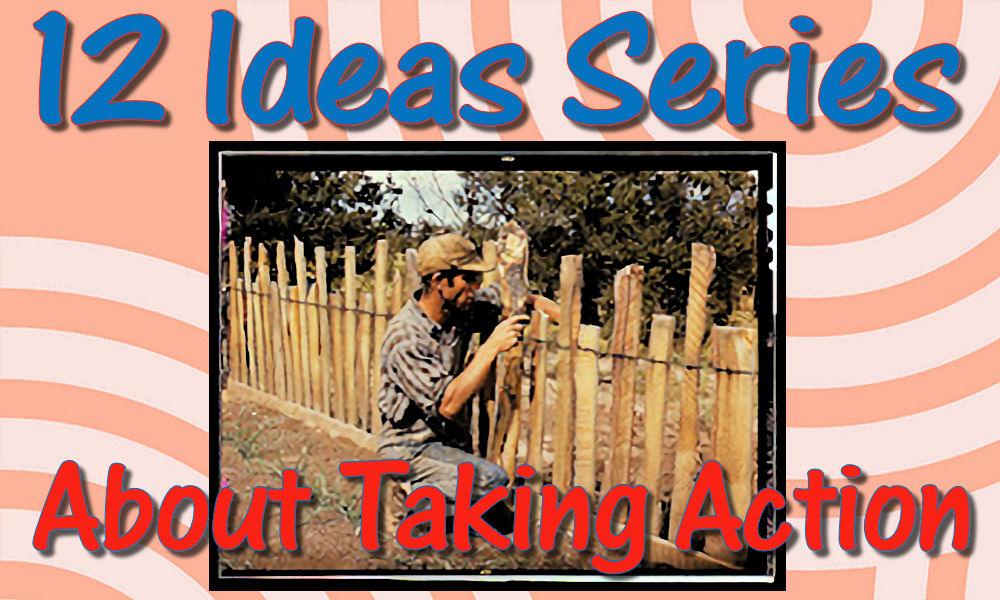- Bring Wisdom — 12 Ideas
- About Anxiety — 12 Ideas
- About Taking Action — 12 Ideas
- About Self Actualizing — 12 Ideas
- About Results — 12 Ideas
- About Mind Movies — 12 Ideas
- About Knowing Yourself — 12 Ideas
- About Being Chained – 12 Ideas Series
- About I‑am-ness — 12 Ideas
- About Happiness – 12 Ideas
- About No Past – 12 Ideas
- About Embodiment — 12 Ideas
About Taking Action — Living your life is a solo project, undertaken in the presence of friends. This step involves a sustained, aggressive, and non-judgemental examination of who you are, what you are doing, and how you are framing your reality. The essential component is non-judgement.

Living Life in Growing Orbits is our workbook.
52 weeks of daily exercises designed to help you figure yourself out.
Check out Living Life in Growing Orbits

For each of us, the path to self-knowledge is a spiral. We go inside and review what we are about, what we “know,” and what we are enacting. We look for blocks, fears, terrors. We reveal our thoughts, feelings, fears, and joys with a select few‑a principal partner, therapist, spiritual director, and Bodyworker. We devise ways to let down our walls and let out the repressed material. We then take in the perspectives of those whom we respect, and use this feedback to nourish more self-knowing.
Actually, this particular process is a spiral, but we’ll get to that in a moment.
I’d like to propose, from the above, that 5 steps or processes are required.
They are sort-of-sequential, and repeat throughout your exploration, for your whole life (that’s the spiral part.)
1. Self-examination
Living your life is a solo project, undertaken in the presence of friends. This step involves
a sustained, aggressive, and non-judgemental examination of who you are, what you are doing, and how you are framing your reality. The essential component is non-judgement.
Judgements are actually excuses for staying stuck, which is what this circular-spiral path combats.

Most people, by the time they get into their 20s, have developed a shtick–a way of presenting themselves–to themselves and to the world.
The odd part is, this shtick is a progression out of the data of the childhood and teen years, and we all know how intelligent and well-versed-in-life children and teens are.
Nonetheless, this script is adopted holus bolus, and when evidence of competence arises, the script is altered to discount the new evidence.
A key part of my therapeutic approach was what I called Radical Disinterest:
- I had no interest in hearing or discovering where this infantile self-view came from.
- I was not particularly interested in the story clients had constructed to support their non-functional beliefs.
- I also did not see much value in debating these beliefs–although this was actually what most clients thought therapy was all about.
Let me give you an analogous situation. You go to a mechanic, who proceeds to tell you about all of the cars he’s broken, all of the mis-diagnoses he’s made, and then he says,
“Well, I’ve never successfully fixed a car, but I have a great set of tools, and lots of books, and I figure that if I keep doing what I’m doing, eventually I’m going to get it right.
No sense getting advice, learning to do things differently, or exploring other options–after all, I learned how to break cars from my dad, who told me it’s just the way I am.
Now, when do you want me to start working on your car?”
Most folk believe that internal states–how one feels, thinks, reacts–are out of their control.
They are correct.
Our patterns are ingrained–they are as much a part of us as our eye colour. This is why having a long conversation (or years of “depth therapy,” about this) is essentially meaningless.
On the other hand, wise folk realize that it’s like this:
“This is my nature, this is how I mess myself up, and here is what I choose to do differently, this time.”
Your key task is to examine how you do life. Pat yourself on the back for what’s working, and then bring your attention to what isn’t. Figure out the pattern. “When ‘a’ happens, I always go into self-judgement, and curl up in bed, and feel sorry for myself.”
Then, move to step 2.
2 — Search for blocks

We are not made up of parts. We are whole.
While Westerners are good at slicing and dicing (“Here’s my mind, and it’s different from my armpit,”) it is only different as to function.
You are all of you, and an essential part of self exploration is learning to read your body for your blockages and containerizations.
Blockages: Our bodies are perfect in their responsiveness. In other words, our bodies reflect the state of our mind (they’re the same thing, actually) and the results of our actions (it’s all the same process.)
Example: if I get angry, there are physiological changes. Muscles tighten, and the free flow of energy is restricted (as is blood flow to extremities, and the gastrointestinal system slows down or stops.)
Searching for YOUR blocks is becoming intimately acquainted with where in your body you hold stress. You do this by noticing, and then monitoring. As you think, react, and act in the world, a part of you pays attention to your body, asking,
“How am I, right now? Am I tight or loose?”
Containerizations: metaphorically, our bodies “hold” blocked energy, just like a cup holds water.

A common container is for our grief: grief “stacks up” on the chest; actually, below the sternum.
Our chests — the heart area — hold this “grief energy.” It’s why we say, “I’m heartbroken” when someone leaves us, as opposed to, “I’m broken-kidney-ed.”
Each of us has one or more favourite places to hold stuff, and paying attention (perhaps during a Bodywork session) helps you to discover yours.
3 — Open revelation
In the top quote, I mention people to open up to–a principal partner, therapist, spiritual director, and Bodyworker. This is the ultimate goal, and the last three could be the same person.
When I say principal partner, I do not necessarily mean a spouse or life-partner. I mean that everyone needs at least one person who is not a professional, with whom they share “What’s up” for them.
This is someone with whom I choose to be open, honest, and vulnerable. I commit to letting this person in on what I am thinking, how I am hurting myself, and what I intend to do with my life and my life-choices.
This person has permission from me to hold me accountable–to remind me that I am committed to doing what I say I’ll do.
This relationship must be reciprocal.
Good friends can act in this role for each other, long-term, or short-term. The “Good Friend Contract” is to listen, to reveal, and to “let it all hang out.”
A Principal partner can also help you with Bodywork, not to replace, but to augment a professional.
Darbella and I work on each other’s bodies regularly–any time either of us notice holding. We do the physical part with each other, without getting into “diagnosis.” I’m not Dar’s therapist, and she’s not mine.
With your good friend or principal partner, you ask for some pressure on a holding point or a container–the partner provides the pressure, the shoulder to cry on, and some Kleenex.
Professionals: If you are working with a professional who is willing to take responsibility for your life, run for the door, rapidly. While your relationship with the professionals listed will be deep and intimate,
- it’s a one-way street, and
- it’s purpose is for the client to receive the therapist’s reflection–to reflect your choices and understandings back to you, and to make suggestions regarding alternative interpretations and behaviours.
- It is not the therapist’s job to get you to do anything–that’s your job.
- It’s not the therapist’s job to persuade you to “see things the therapist’s way.”
Therapeutic mirroring helps you to see the results of your choices, directly and without judgement, and then to make other choices.
4 — Letting go
It’s not enough to talk about this stuff.
The key to living life with depth and elegance is “doing.”
It is not what people intend–it is what they do.
Let’s say you buy a copy of my book, The. Best. Relationship. Ever.
You commit to talking with your principal partner, in depth, for 30 minutes per day. The only thing that matters is this: “Did you do what you said you’d do?”
Many people are expert at excuse making. Excuses are nothing more than laziness. Our egos are invested in our staying stuck, so they provide an excuse so you can keep reacting in old ways.
It’s important to note that this work is solely self-responsible.
Taking Action is not a tool to get others to change, and there’s no expectation that others are “going to” cooperate with our work. We learn to stop disturbing our own tranquility as others do what they do.
It’s not the job of others to walk in front of you, filling in the holes and keeping you from falling over.
5 — Shift behaviour

i see this as such a key to this work, that I gave it separate billing, despite the other 4 also being “behaviour shifts.”
To say it again, the only important thing in all of this is what we choose to do.
Many people “get” what I write or talk about. It makes sense, until it collides with one or more of their sacred cows. Then, out come the stories, evasions, and excuses.
And inevitably, the stories reduce to “Others have hurt me and made me powerless,” or “I’m dysfunctional, and incapable of making other choices.”
We say, “Others did what they did, and you are who you are, and every time, there is choice.”
Many, many people give up at this “choice point.” It’s as if they have so much invested in the “sacred cow,” that they’d rather stay stuck and in pain. They’ve viewed their reality according to a “helpless” model for so long, that dropping it seems impossible.
Oddly, it IS impossible.
As I said above, those voices of helplessness are as old as you are. They are not going anywhere. Your history is your history, and we’ve all experienced “bad stuff.”
Thinking, “That shouldn’t have happened,” while perhaps true, is a waste of time contemplating, as what has happened is what has happened.
We suggest acceptance of ourselves as we are.
Then, work from there.
So, as the “helpless voice” arises, you learn to be tolerant and sympathetic of yourself. You hear it, honour its existence, and then make other choices. Again, and again. Until you die.
The “choice to make another choice” requires vigilance and diligence.
Our tendency, like in the ‘mechanic story,’ is to do the familiar, while justifying the non-functioning behaviour. We need to learn to stop ourselves, and to experiment with other ways of being and acting.
Much like changing any bad habit, shifting to another way of being and acting takes time. Beating up on yourself for missing an opportunity accomplishes nothing, so you might as well just get back to doing the new thing, as soon as you notice you’re off track.
The spiral

Finally, let me note that “life is a spiral”… because personal work goes on and on.
It’s like we are walking up a spiral staircase. We get better and better at implementing our new understanding, and then we confront a more complex version of the same issue, and are once again thrown into confusion.
The way out, however, never changes.
You enter the sequence of 5 steps again, only this time, with greater understanding. You see through the illusion you are creating, and shake your head, stop the non-functioning behaviour, and engage with life self-responsibly.
Around and around we go, and we soon see that the pattern of engagement never changes.
What arises, arises, and we want to grab it and make it big, scary and important. We have a breath, relax our grip, let go of the emotions, and take the next step. And the illusion we have created goes “poof.”
This is the only “real” game in town.


